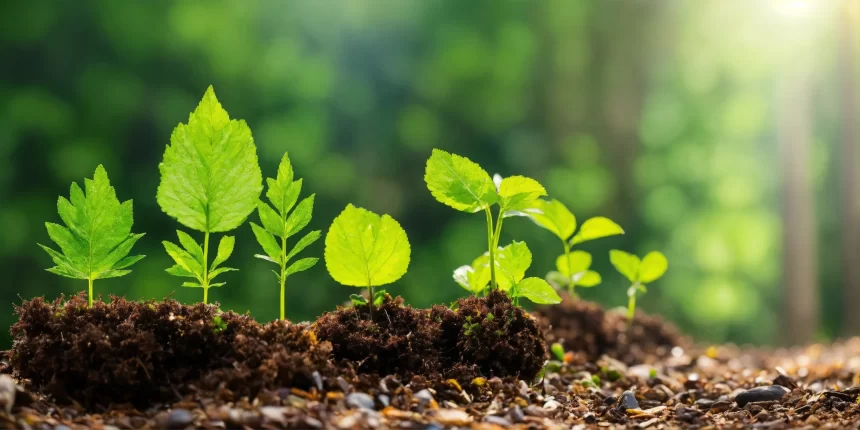Starting seeds is one of my favorite parts of gardening. I love watching those tiny seeds sprout and grow into healthy seedlings that will eventually produce delicious fruits, vegetables and flowers in my garden. As an avid gardener for over 20 years, I’ve learned a lot about seed starting through trial and error.
I’ll share with you my proven seed starting schedule for getting a head start on the growing season and giving your garden plants the best chance at success. I’ll provide tips on timing, materials, growing mediums, fertilization, lighting conditions, hardening off and transplanting seedlings. Whether you’re new to growing plants from seeds or looking to improve your current process, you’ll find valuable information here that can set you up for gardening success.
Why I Start Seeds Indoors
I start most of my garden vegetable and flower seeds indoors for a few key reasons:
Avoid Frost Damage
In my area, frost is still a risk early in the outdoor growing season. Starting seeds indoors allows me to get my plants off to an early start without worrying about cold damage. The seedlings are protected and can grow large enough to withstand some cold snaps.
Lengthen the Growing Season
By starting my seeds weeks or months before my last expected frost date, I give my seedlings a size advantage going into the ground. This head start on growth enables me to harvest my garden plants earlier and for more extended periods compared to direct sowing seeds outdoors. More time to grow means higher yields.
Better Germination Rates
I find that seeds germinate much quicker and more uniformly when sown indoors. The warm, stable environment helps break seed dormancy. Plus, it’s easier to maintain consistent moisture levels potting mix versus outdoor soil early in the growing season. My plants get off to a vigorous start right from the beginning.
More Plant Variety
My outdoor gardening space is limited, so starting seeds indoors allows me to grow so many more types of plants compared to just direct sowing. I can experiment with different varieties without sacrificing valuable real estate in my vegetable beds and flower gardens.
It’s Fun!
Finally, starting seeds satisfies by gardening obsession in the offseason. It’s just plain fun to nurture those seedlings and watch daily growth progress. And it gets me excited for the upcoming growing season.
My Indoor Growing Area Setup
Creating the proper indoor environment will set your seed starting efforts up for success. Here’s my take on it.
Grow Lights
One of the biggest challenges with starting seeds indoors is providing adequate sunlight. I use a four-shelf metal plant stand outfitted with T5 fluorescent grow lights. The tubing emits light wavelengths that plants need for photosynthesis. I keep the lights on for 16 hours per day at the maximum height of an inch or two above the seedlings for 14-16 hours daily. As the plants grow, I raise the lights accordingly.
Heat Mats
I use electric heat mats designed specifically for seed germination. They gently warm the soil to speeds up the process and leads to very high germination rates. I put the heat mats on the bottom shelf of my plant stand to conserve space.
Fans
Proper air circulation is crucial to prevent fungal diseases like damping off. I use small clip-on fans on a low setting to gently blow across seedlings, mimicking natural wind. Good airflow also strengthens delicate stems.
Humidity Domes
Seedlings thrive in humid conditions, especially when just sprouting. I create mini greenhouses by covering seedling trays with plastic humidity domes to keeps moisture and humidity levels high. Once the first true leaves appear, I remove the domes.
With the right equipment, you can successfully recreate ideal growing conditions for starting seeds indoors.
My Seed Starting Mix Recipe
A good seed starting mix provides the air pockets for young roots to spread out while retaining the right amount of moisture and nutrition.
Here’s my go-to homemade potting mix formula:
- 2 parts sphagnum peat moss – retains moisture
- 1 part perlite – improves drainage
- 1 part vermiculite – holds nutrients
- 1 tablespoon lime per gallon of mix – balances acidity
I dampen the potting mix with warm water before filling seed trays or starter pots. After planting seeds according to package directions, I lightly cover them with more mix or vermiculite to retain moisture during germination.
Store-bought seed starting mix works too, but I’ve had great success with this homemade blend. And I know exactly what’s going into it.
My Seed Starting Schedule by Month
Timing is everything when it comes to starting seeds. Here is my detailed schedule based on my last frost date of May 15:
January
- Start brassicas like broccoli, cabbage, cauliflower and kohlrabi indoors. They take 80+ days to mature, so mid-January sowing gives them time to grow large before transplanting after the danger of frost passes.
- Begin flowers like pansies, snapdragons, petunias and flowering kale that also prefer cooler weather.
- Start herbs like parsley, cilantro, oregano, thyme and basil. Herbs despise being transplanted, so it’s best to sow them in pots they will stay in.
February
- Sow warm weather crops like tomatoes, peppers and eggplant. The seeds need 8-10 weeks indoors to grow before hardening off and transplanting outside later in spring.
- Plant more cool weather crops like Brussels sprouts, lettuce, spinach, Swiss chard and kale. They can tolerate some frost.
- Start zinnia and marigold seeds, which grow quickly from seed to brighten up spring beds and pots.
March
- Continue starting warm weather plants like squash, melons, cucumbers, pumpkins and beans.
- Sow successive crops of quick-growing salad greens and radishes for early spring harvest.
- Start wildflower mixes outdoors if the ground can be worked.
- Plant more herb varieties like dill, fennel and chives.
April
- Begin sowing seeds directly outdoors as soil warms up, including root crops like carrots and beets.
- Transplant sprouted vegetable and flower seedlings into the garden after hardening off.
- Plant warm season annuals and herbs outdoors.
- Start harvesting cool weather crops planted earlier.
May
- Plant heat lovers like okra, southern peas, basil and watermelon outdoors.
- Sow a new batch of beans and quick-growing vegetables for continual summer harvest.
This schedule ensures I have a productive garden from early spring through first fall frosts!
Daily Care for Seedlings
Caring for your seedlings every day is just as important as timing their initial sowing properly. Here is my regimen:
Ensure Adequate Light
Seeds sprout faster and grow stronger with sufficient light. As soon as I see green popping through the soil, I make sure my grow lights are lowered to just an inch or two above. I gradually raise them as seedlings stretch upwards. Rotate trays occasionally so all sides get equal light exposure.
Maintain Even Soil Moisture
Seedlings are very susceptible to drying out. I check daily and water when the top of the potting mix feels barely moist. As a general rule, I water from the bottom by placing pots in a tray of water for a few minutes to soak it up. This prevents disturbing delicate roots.
Moderate Temperatures
I check that my heat mats are keeping pots consistently around 70°F. Cooler temps delay germination while too hot slows growth. I monitor room temps and use a small space heater or fan to maintain an optimal range.
Fertilize Lightly
When true leaves emerge after seed leaves, I begin occasional light fertilization using quarter strength all-purpose liquid fertilizer. This gives just enough nutrients for growth without burning tender roots.
Allow Air Circulation
I run my fans daily, pointed away from seedlings to avoid drying them out but still allowing gentle stem movement. Rotating pots stimulates even growth on all sides. Good airflow prevents disease issues.
Watch for Issues
I check daily for any insect infestations, fungi like damping off, irregular growth or environmental stresses. Catching problems early allows me to correct conditions and save plants.
Hardening Off Prepares Seedlings for Transplanting
A week or two before I’m ready to transplant seedlings into outdoor beds, I start the hardening off process. This gradually exposes the tender plants to harsher outdoor elements, avoiding transplant shock.
Here are the steps I follow:
- Move Containers Outside: I place seedlings outdoors in a shady spot for a just few hours, bringing them back inside at night. I slowly increase outdoor time over a week.
- Allow Wind Exposure: After several days, I move containers to a location that gets periodic wind, which strengthens stems. I monitor for any leaf burn and only leave out for a short periods.
- Withhold Water: About a week before transplanting, I stop watering pots. This slows growth whileforcing roots to grow downwardseeking moisture. Both factors reduce transplant trauma.
- Allow Sun Exposure: Finally, I move seedlings to mostly sunny areas for a couple hours per day. This is the last hardening off step before transplant day. It thickens leaves and prepares plants for full sun exposure. I watch closely for any wilting and move back to shade if necessary.
Taking it slow with hardening off is key. Gradually introducing outdoor conditions gives my seedlings the fortitude to flourish when planted in garden beds.
How I Transplant Seedlings for Continued Success
On transplant day, I adhere to these tips for ensuring my seedlings transfer successfully from pots to garden soil:
Time it Right
I wait until after my last frost date when soil has warmed up, generally mid to late spring. I also consider crop-specific frost tolerance for cooler weather vegetables I’ve started early.
Prepare Planting Holes
I dig holes slightly larger than each plant’s root mass and spacing according to seed packet guidance. Looser soil encourages establishing new roots. As I dig holes, I mix a handful of bulb fertilizer into the bottom for an extra nutrient boost upon planting.
Water Seedlings Well
A few hours before transplanting, I thoroughly water pots to moisten root balls for easy removal without damaging delicate roots and stems.
Carefully Remove Plants
When lifting each damp plant, I gently loosen roots from sides and bottom of pots to coax white healthy tips into view. This indicates my seedlings are actively growing and ready to flourish. I transplant any root bound plants a little deeper to encourage new root branching.
Backfill Soil
Holding plants upright at the same level they grew in pots, I backfill half the hole with native soil. I create a small watering basin around each seedling and soak the base before mounding remaining soil. Finally, I apply another deep watering after transplant to further settle roots.
Provide Shade
I fashion temporary shade coverings from old bed sheets or row cover fabric draped over frames for newly transplanted crops for their first several days. Filtered light reduces wilting. Once I see new growth, I remove extra shade to avoid stretching stems.
Following these careful steps when moving seedlings from pots to outdoor beds helps minimize transplant trauma. With tender loving care, my homegrown plants quickly adapt and start rapidly growing to their full garden glory.
FAQs
Most seeds germinate best at temperatures between 70-80°F. I use seedling heat mats set to 75°F to create ideal warmth for sprouting.
Check soil moisture daily by touching the top of the potting mix. Water seedlings when the top inch feels dry. Be careful not to oversaturate, as dampness causes fungal issues. I bottom water pots for 30 minutes until the surface is moist.
Insufficient light often causes seedlings to become tall, weak and leggy as they overreach for light. Ensure grow lights are just 1-2 inches above sprouts, raising them as plants grow. Rotate pots for even exposure.
It’s time to harden off and transplant most seedlings after the last expected spring frost in your area when soils reach 60°F. Check crops for their individual frost tolerance before exposing tender plants. Gradually acclimate for 7-10 days.
Hardening off transitions indoor plants to outdoor conditions over 7-10 days. Set containers in shady spots, slowly increasing sun and wind exposure while reducing water to encourage root growth. This prevents transplant shock.
Gently loosen encircling roots or transplant root bound plants a little deeper to promote new root growth. Trim any severely tangled roots before planting. Water well after transplanting to help recovery.
Enjoy Continual Harvests from My Early Starts
Starting my vegetable, herb and flower garden seeds early indoors extends harvests by weeks or months compared to if I direct sowed outdoors alone. I enjoy continuous bountiful yields along with colorful bouquets from early spring frosts well into fall.
I believe my seed starting schedule shared here gives all types of plants I grow the best chance to thrive. My tips equip home gardeners with the key information needed to manage healthy seedlings ready for transplant. Then they can reap their own successful gardens!
With some planning and preparation, you too can produce robust homegrown plants, vegetables, herbs and flowers even as a beginner. Just follow this comprehensive guide to seed starting developed from my years of hands-on gardening experience. Let me know if you have any other questions in the comments! I’m always happy to help fellow gardening enthusiasts. Now let’s get growing!




